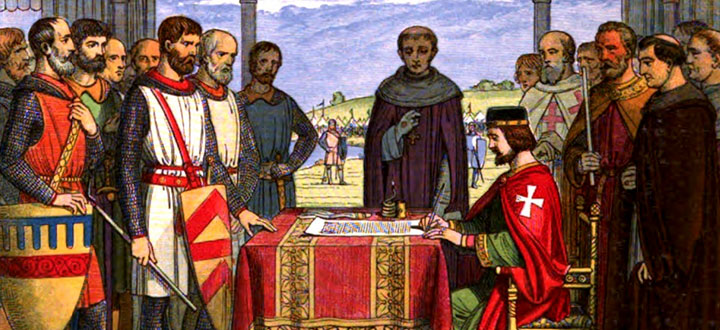Eight hundred years ago, on June 15, 1215, a group of English noblemen stood in Runnymede meadow along the Thames River and said, “No”—no to unlimited monarchical power, no to confiscation of property with impunity, no to legal proceedings without due process. These so-called rebel barons persuaded the reluctant King John to affix his seal to the Magna Carta, the “Great Charter.” This was a major step toward the conception and implementation of properly limited government.
Specifically, the Magna Carta set boundaries within which individuals, as well as corporations such as the English church and the City of London, would be free to act without unjustified government intrusion. The charter stated that the government could arrest people only for violations of publicly known laws; that all arrests must be conducted publicly, with a credible witness attesting to the charges; and that the accused were entitled to a swift trial by a jury of their peers. It further stated that the government could not take merchants’ or homeowners’ goods or land without prompt and just compensation, and that the government may not impose excessive fines—meaning, fines that amount to an unjust taking of one’s means of living.
The Magna Carta’s main tenets were integrated into English statute law by 1300 and common law thereafter. This Great Charter was the basis on which jurists such as Edward Coke and William Blackstone rejected the divine right of kings and developed their rights-oriented approach toward legal theory. In the Glorious Revolution of 1688, Parliament checked the Crown’s arbitrary wielding of power, in part, by grounding their arguments in the aforementioned ideas set forth in the Magna Carta.
The Magna Carta was a profound development on the road to a civilized, rights-based society; and the document has had vital, long-reaching ramifications. For instance, several of the original thirteen American colonies modeled their charters on this Great Charter. Leaders of the American Revolution rebelled against King George for violating the “rights of Englishmen”—rights they regarded as implicitly recognized in the Magna Carta. Various elements of the U.S. Constitution—including the due process clauses of the Fifth and Fourteenth Amendments; the writ of habeas corpus in Article 1, Section 9; and the assurance in the Ninth Amendment that the people retain all non-enumerated rights—derive from clauses in the Magna Carta that explicitly limited the state’s power. And U.S. Supreme Court justices have cited the Magna Carta as legal precedent on numerous occasions. For example, the 1989 Browning-Ferris Industries v. Kelco Disposal case concerning excessive fines—and thus property rights—mentions the Magna Carta forty-four times.
In short, the Magna Carta was a pivotal document toward properly limited government.
As Americans prepare for Independence Day celebrations, we would do justice to tip our hats in gratitude to the men who crafted this Great Charter that laid crucial groundwork in support of our cherished liberties.
Here’s to the rebel barons who stood up to a king so long ago!
Related:
- Ayn Rand’s Theory of Rights: The Moral Foundations of a Free Society
- Capitalism and the Moral High Ground
- A Civilized Society: The Necessary Conditions














